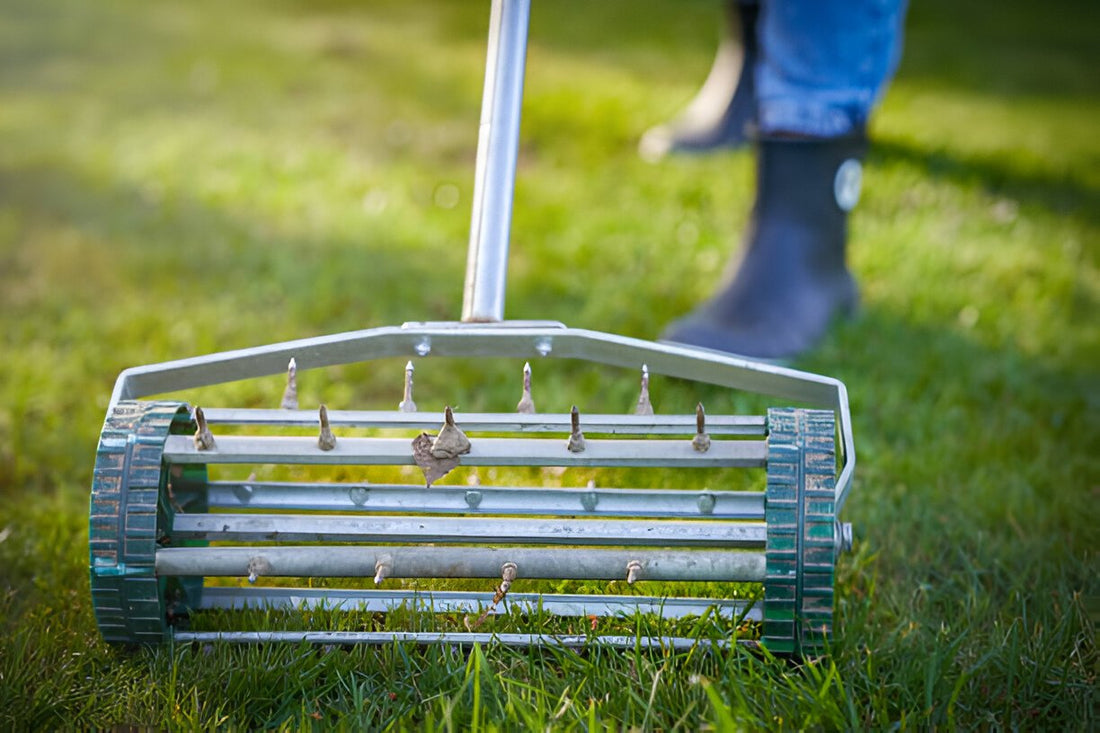Maintaining a vibrant and healthy lawn is no small feat, but aeration followed by the right fertilizer can make a world of difference.
If you're looking for the best lawn fertilizer after aeration, you've come to the right place. As lawn care experts, we know that the proper post-aeration care is essential to keep your lawn thriving.
In this article, we'll dive deeper into selecting the best lawn fertilizer after aeration and provide a step-by-step guide on how to fertilize your lawn after aeration. So, if you're ready to give your lawn a makeover, continue reading.
We'll cover why aeration is important, whether you should fertilize or aerate first, the optimal timing for these tasks, and the best techniques for fertilizing post-aeration.
What this article covers:- Why Aerate Your Lawn?
- Should I Fertilize or Aerate First?
- When Should I Aerate and Fertilize My Lawn?
- How to Fertilize Your Lawn After Aeration
Why Aerate Your Lawn?
Aeration involves perforating the soil with small holes to allow air, water, and nutrients to penetrate the grass roots.
As per our expertise, this process helps alleviate soil compaction and promotes root growth. It's a game-changer for improving the overall health of your lawn.
When soil is compacted, it restricts the flow of essential nutrients and water to the roots, which can stunt grass growth and lead to a patchy, unhealthy lawn. They tend to lay on top of the soil, not providing any benefit to the lawn.
By aerating, you create pathways for these vital elements to reach deep into the soil, enhancing the lawn's resilience and vibrancy. By getting these elements into the soil, they can begin to work enhancing the beauty and health of your lawn.
It's important to have the right lawn fertilizer after aeration. We currently have two variations:

Emerald 10-0-20 Lawn Fertilizer, with 10% iron and added GreenTRX Starter Fertilizer 15-20-10 that contains phosphorus and iron and is better for seed germination.
Emerald 10-0-20 fertilizer contains a balanced ratio of nitrogen and potassium, with no phosphorus added, making it ideal for tall fescue lawns, centipede lawns, St. Augustine, and other turf grasses that require a high level of potassium.
Formulated with 45% slow-release technology, it ensures a steady and consistent release of nutrients over time. This helps to prevent over-fertilization and reduces the risk of fertilizer burn, making it safe for use on all types of lawns.
The Emerald 10-0-20 Lawn Fertilizer not only supports healthy growth but also strengthens the grass, making it more resistant to stress and diseases.
When overseeding, our Starter Fertilizer 15-20-10 is a much better choice. Containing phosphorus, it helps quickly develop roots and gets new seedlings started fast. It also contains slow-release nitrogen to continue feeding after germination. It is the go-to fertilizer for starting new grass seed.
Should I Fertilize or Aerate First?
Based on our observations, the best approach is to aerate first. Aerating the lawn before fertilizing ensures that the nutrients from the fertilizer reach the roots more effectively, enhancing their impact.
When you aerate first, you create small holes in the soil, allowing air, water, and nutrients to penetrate deeply. This process reduces soil compaction and promotes healthy root growth.
Once the soil is aerated, applying fertilizer takes advantage of these openings, ensuring that the nutrients are absorbed efficiently by the grass roots.
This is one of the best times to also apply BioBoost Organic 5-3-0 Fertilizer to the soil. Getting organics into the soil provides a ton of benefits to the lawn.
- Raises CEC levels - Enhances Nutrient Utilization
- Increases organic matter in the soil
- No Burn Formula
- Very beneficial for new construction homes to build up the soil where the topsoil has been removed.
This method maximizes the effectiveness of the fertilizer, leading to a healthier, more vibrant lawn. Our findings show that aerating first, followed by fertilizing, results in better nutrient uptake and overall lawn health.
When Should I Aerate and Fertilize My Lawn?
Timing is everything. The best time to aerate and fertilize your lawn is during the growing season when the grass can heal and fill in any open areas after soil plugs are dissolved.
For cool-season grasses, early spring or fall is ideal. For warm-season grasses, late spring to early summer works best.
Our findings show that aligning aeration with the growing season maximizes the benefits. Additionally, the time of day matters as well.
The best time of day to fertilize lawn and aerate is either early in the morning or late in the afternoon. This timing helps avoid the intense midday heat, which can stress the grass and reduce the effectiveness of both aeration and fertilization.
Early morning or late afternoon aeration allows the lawn to recover more quickly and ensures that the fertilizer is absorbed efficiently.

How to Fertilize Your Lawn After Aeration
Let's look at a step-by-step process on how to fertilize your lawn after aeration:
Overseed Your Lawn
After aerating, consider overseeding your lawn to fill in bare spots and improve turf density. This step can be particularly beneficial if your lawn is thinning or if you want to introduce a more resilient grass variety.
Overseeding involves spreading grass seed over the existing lawn. This not only fills in patches but also enhances the overall health and appearance of the lawn.
The new grass will grow alongside the existing turf, creating a thicker, more lush lawn that is better able to resist weeds and disease.
Apply Fertilizer
Now comes the crucial step of applying fertilizer. Whether you're looking for the best lawn fertilizer for spring or the best lawn fertilizer for winter, opt for a fertilizer that has a balanced ratio or one that is high in nitrogen, promoting vigorous growth.
A great choice would be the Starter Fertilizer 15-20-12 with Iron, a high nitrogen lawn fertilizer that encourages growth and strengthens turf. This fertilizer is high in nitrogen but slow-release, perfect for revitalizing lawns and boosting growth. Also, it contains phosphorus which is key for getting new seedlings to grow. Phosphorus is needed for root development.
Use a spreader to ensure even distribution, and water your lawn lightly afterward to help the fertilizer penetrate the soil. This method ensures the nutrients are absorbed effectively, promoting a healthier lawn.

Reseed Your Lawn If Necessary
If there are still bare patches after overseeding and fertilizing, reseeding might be necessary. This ensures every part of your lawn receives the care it needs to thrive.
Reseeding involves applying additional grass seed to areas that have not responded as well to initial overseeding efforts.
By targeting these stubborn patches, you help create a uniform and dense lawn. Ensure the soil is moist and lightly cover the seeds with a thin layer of soil or mulch to protect them as they germinate.
Avoid Walking On The Lawn After Aeration
To give your lawn the best chance to recover, avoid heavy foot traffic for a few weeks post-aeration. This allows the soil plugs to break down naturally and prevents any new compaction.
Keeping off the lawn during this recovery period ensures that the grass roots can expand and take full advantage of the improved soil conditions created by aeration.
By minimizing disturbance, you support the lawn's ability to grow stronger and more resilient.
Conclusion
Transform your lawn into a lush, green oasis with the right care strategy. Aerating your lawn is the first step to unlocking its full potential by reducing soil compaction and allowing vital nutrients to reach the roots.
Timing and technique are crucial—aim to perform these tasks during the growing season and in the cool parts of the day for the best results.
To achieve the lawn of your dreams, trust Lawn Synergy to guide you through every step of the process. With our expertise and lawn care subscription service, we help you create a lawn that’s not only beautiful but also healthy and resilient. We will deliver the right fertilizer at the right time for your lawn so that your lawn is always fed.
Take the first step towards a greener lawn today—visit Lawn Synergy and let us help you transform your outdoor space into a stunning landscape.
If you want to learn more, why not check out these articles below:
- Best Time to Fertilize Lawn Before or After Rain
- Best Time to Fertilize Lawn Before or After Mowing
- Best Fertilizer for Yellow Grass
- Best Fertilizer for Bahia Grass
- Best Fertilizer for Tall Fescue Grass
- Best Weed and Feed for St. Augustine Grass
- Best Fertilizer for Centipede Grass in South Carolina
- Best Grass Seed Fertilizer
- Best Fertilizer for Mondo Grass
- Best Lawn Fertilizer
- Best New Lawn Fertilizer
- Best Organic Fertilizer for Lawn
- Best Weed and Feed for Lawns
- Best Lawn Fertilizer for Texas
- Best Lawn Fertilizer for Florida

